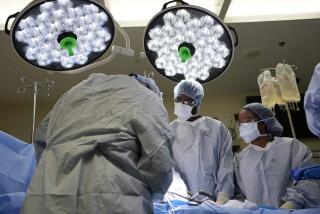Getting medical students to see
- Share via
PHILADELPHIA — Modern medicine provides doctors with an array of sophisticated machines that collect and present data about their patients, but the human eye is an invaluable yet often underappreciated diagnostic tool.
To address that, a new collaboration of Jefferson Medical College and the Pennsylvania Academy of the Fine Arts has been created to teach aspiring doctors to closely observe, describe and interpret the subtlest details with the eye of an artist.
The art-and-medicine program kicked off its first workshop recently with a group of 18 white-coated medical students visiting the academy’s museum and a dynamic representation of their chosen profession: Thomas Eakins’ masterwork “The Gross Clinic,” which depicts an operation in progress.
The first- and second-year med students heard how to take a “visual inventory” -- looking at overall elements of the painting, such as texture and brightness, and specifics, such as body language and facial expressions.
“This collaboration with our art colleagues is a wonderful augmentation to what we’re already doing,” said Dr. Charles Pohl, a professor of pediatrics at Jefferson and co-instructor at the workshop. “We can learn from the masters to really fine-tune our attention to detail.”
Besides the two-hour “Visual Perception” workshop, others slated for the 2007-08 school year are “Accuracy and Perception,” ’Hand-Eye Coordination,” “Art in Healing” and “Sculpture and Surgery.” The courses are a mix of demonstrations, lectures and hands-on art lessons.
A 2001 study in the Journal of the American Medical Assn. found that medical students in a similar Yale University program acquired more astute observational skills than their colleagues who didn’t take the courses. Besides assessing a patient’s well-being during an office visit, finely honed visual abilities can also allow doctors to spot subtle changes in a patient’s X-rays over time, for example.
“When they can take a better look at the person in front of them, it helps them make better diagnoses and leads to improved sensitivity to the patient,” said the academy’s painting department chairman, Al Gury, and workshop co-instructor. “That’s a critical area that many feel is needed in the medical profession.”
Medical schools nationwide are increasingly adding humanities courses to their curricula.
According to the Assn. of American Medical Colleges, 89 of the country’s 125 medical schools have humanities as an educational element included in a required course and 66 have it as an elective. (There’s overlap because some schools have both.) The figures include all humanities, not just visual arts, spokeswoman Nicole Buckley said. Other humanities studied in medical schools include literature, performing arts and music.
The Medical College of Wisconsin has a one-month medical humanities elective for fourth-year medical students, and Weill Cornell Medical College in New York City established a program with the Frick Museum.
Though fine art may be unexplored territory for some Jefferson medical students, many of their artistic contemporaries at the academy are no strangers to the world of science.
“Our students go to the gross anatomy labs in their upper-level anatomy study,” Gury said. “But this is the first time we’ve hosted the medical students.”
More to Read
Sign up for Essential California
The most important California stories and recommendations in your inbox every morning.
You may occasionally receive promotional content from the Los Angeles Times.









